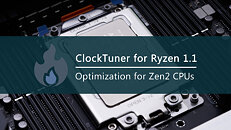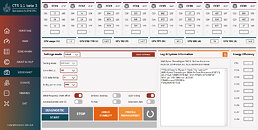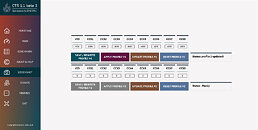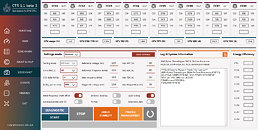Saturday, October 17th 2020

ClockTuner for Ryzen Version 1.1 Released
Yuri "1usmus" Bubliy released the latest version of ClockTuner for Ryzen (CTR), a utility for perfecting an AMD Ryzen-powered PC overclock. CTR lets you easily implement the most optimal clock, voltage, timing, and memory settings for your desktop, and squeezed out levels of performance previously not thought possible, with users reporting double-digit percentage performance gains for practically free.
Version 1.1 introduces a handful new features. For starters, the app's user interface comes with a separate profile management page, which can be accessed by clicking on the "profile management" button. It's now easier to reset the settings. Tool-tips across the app have been improved. CTR 1.1 also introduces additional internal checks to ensure a frequency step up doesn't run into voltage droop. Improvements have been made to the app's engine to ensure the correct commands are sent to the registers, and the "check stability" function.
DOWNLOAD: Clock Tuner for AMD RyzenThe change-log follows.
Version 1.1 introduces a handful new features. For starters, the app's user interface comes with a separate profile management page, which can be accessed by clicking on the "profile management" button. It's now easier to reset the settings. Tool-tips across the app have been improved. CTR 1.1 also introduces additional internal checks to ensure a frequency step up doesn't run into voltage droop. Improvements have been made to the app's engine to ensure the correct commands are sent to the registers, and the "check stability" function.
DOWNLOAD: Clock Tuner for AMD RyzenThe change-log follows.
- The profile management buttons have moved to a separate page, which can be accessed by pressing the "PROFILE MANAGEMENT" button. The user now has 2 slot profiles to which he can record the results of the current experiment or make manual corrections.
- A button has been added to reset the settings and pop-up tooltips have been added. The log has been slightly transformed and additional information can be displayed in it, which will allow the user to solve problems on his own without resorting to forum discussions. As an additional help, a button-link to the English video guide has been added to CTR 1.1 (Russian video guide will be added soon). It is located in the "ABOUT & HELP" tab.
- In "Settings mode" user can include additional settings, which will be useful only for advanced users. That is, we have the concept of CTR in 2 clicks (DIAGNOSTIC - START).
- CTR 1.1 got a new engine with some additional rules. Now, before making a step to a higher frequency, CTR checks the current frequency with reduced voltage relative to the reference one. In most cases, this can prevent BSOD during the frequency step or high Vdroop. It also helps to prevent the system from false pitch to a higher frequency if the CCX is on the edge of instability.
- Another important advantage of the new CTR 1.1 engine is the new, secure method of controlling the frequency and voltage of the processor. This will protect user systems from sending incorrect commands to registers.
- The load level of stress tests has been corrected for all processors and all modes. Now uses a more loyal value of FFT, which can protect the system from BSOD.
- Load Line Calibration level requirements have been revised and thanks to the new CTR rules you can use LLC in Auto mode (in most cases you will not need to use LLC Mode 3). This also means that ASRock and Gigabyte motherboards are fully supported.
- "Enhance accuracy" is a system of additional frequency step crushing using voltage. Depending on the reference voltage value, the CTR selects the optimal number of extra steps. Yes, the "tuning" process becomes longer, but the results are more accurate.
- The diagnostic mode has received a number of improvements. Step time was increased and stress load was corrected using FFT. This significantly reduced the probability of BSOD. The evaluation of the cooling system allows to automatically offer the user the optimal mode. It can be an undervolting mode or an overclocking mode with the current PPT level saved. That is, if you use a BOX cooler, you will be automatically offered an undervolt mode, which has a chance to reduce the processor temperature in the load up to 15 degrees (and reduce the noise level).
- The system of penalties for creating the final profile was redesigned. Now the penalty will depend on the maximum processor temperature during the diagnostics as well as the current Vdroop level. This allows the profile to have some additional stability reserve.
- "Autoshare stats" allows you to send the result of successful system tuning to the server. The report contains all the information available on the "BENCHMARK" tab. After sending the result to the user, the window with the stored results on the server will automatically open. Access to the results is open for everyone.
- "CHECK STABILITY" is an opportunity to check the system for stability. Basic time is 10 minutes if "Enhance accuracy" option is enabled - 20 minutes. If an error is found - the stress test will be stopped immediately. You may not be afraid to leave CTR unattended.
- EDC, TDC, PPT and Max temperature values are corrected. Now the CTR protection system will not react so hard on user experiments.
- Note. EDC, TDC, PPT and Max temperature values do not apply to PBO or telemetry settings, do not affect the CPU protection system and do not affect system performance.
- The last important innovation is the ability to use CTR without SMT.
- And, of course, numerous bugs have been fixed. Improved support for Ryzen 3 3100, Ryzen 5 3500 and Ryzen 5 3500X processors.




35 Comments on ClockTuner for Ryzen Version 1.1 Released
So you'll likely never see this backported.
My Threadripper 3960X gained 1000 points in CB20 for free (within the same power envelope). 12900 vs 13876 points.
I don't get these programs, though, if they don't reflect how pbo works and only affectsmanual oc.
You lose a lot of single-core boost headroom in my experience with CTR v1.0 but will try again with 1.1
Any suggestions on limits I should set? I'm running a Hyper 212 Black so better than stock but obviously not a big cooler or AIO.
Then I just used CTR to do the CPU part. I honestly feel like this program was purpose built for people like me. A little bump to performance for those with little time or simply can't understand.
You cannot use pbo to full extent if you cannot cool your cpu, I agree in that sense clocktuner is easier in that case; though how safe I wonder. You would be better served sticking to defaults imo. We have plenty of users, buildzoid included, who have egregiously fried their chips(he didn't even pay attention to how his motherboard was reporting high-load voltage levels). I see no fun in that for a couple of months of unsupervised electromigration.
www.techpowerup.com/forums/threads/is-this-noctua-nf-f12-ippc-3000-pwm-worth-it-static-pressure-7-63-mmh2o.273391/post-4370777
I give a bunch of cpu cooler examples here. Yours is like a mini 34.
Edit. I searched on MSI site and they seem to have it only under intel MBO's.
Edit 2. I did find it. Set it to 3 as recommended. Idk is this AMD thing with them being notorious for their garbage drivers, but now my CPU is superovervoltaged and clock reduced. I was able to set 4.2GHHz and 1.1V on core manually. Super stable. Now this program recommends 3950MHz and 1.275V. And auto OC in Ryzen Master Recommends 1.475V!!! for 4.3GHz. Somehow, for whatever black magic reason, even after setting LLC back to auto, that magical 4.2GHz with 1.1V is impossible.
normally i take 75% so if there is a 1 to 10 setting like in asus bios i would take 7 or 8 so that for Example 1,250 volt is circa 1,225 under load.
CB20 went from 7200-ish to 7700, which is great.
single thread lost ? There is nothing single threaded nowadays, not even notepad ;)
by the way I went from 524 to 510 points CB20 single thread, so I wouldn’t call it “a lot” of damage.
I’m using CCX1 and CCX2 @ 4400 MHz and CCX3 and CCX4 @ 4200 MHz, at 1.250 V on a silver sample 3900X
Let's say I'm happy with my 3900X but don't like the voltage and subsequent temperature spikes that are applied to reach 4.6GHz by default. I don't want to underclock but I'm wondering if there's an fast and easy way to find the undervolt sweet spot.
Set undervolt offset for example 0.050V
Test with Prime95 Small FFT's (second option) AVX all enabled and let it run through all FFT sizes.
If you don't have a core that crashes it's stable.
Rinse and repeat (with bigger undervolt offsets until it gets unstable).
Don't go more than 0.100V undervolt, even before that you will lose boostspeeds.
I run 0.050V undervolt myself.
It's literally a soft mod for PBO. It changes the clock/volt/frequency tables of PB/PBO.
PBO doesnt change voltage o frequencies. It just modifies CPU limits (EDC, TDC and PPT).